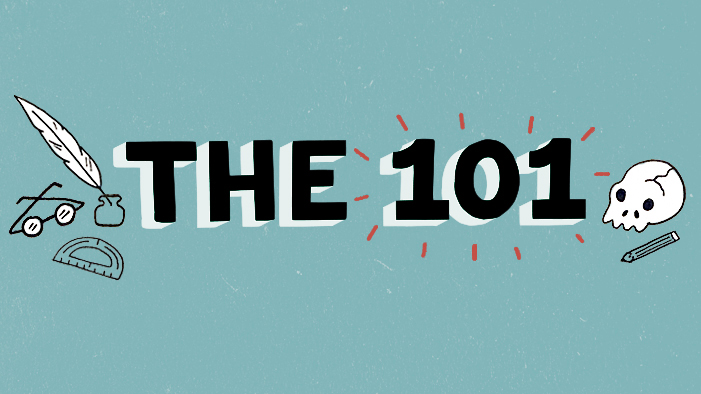End Stopped Line Definition Poetry

"The poetic line" is the fancy term for a line of poetry; it can stop at a single word—an "of" or "the" or "hippopotami"—or keep going until it hits the margin, or, even, with correct formatting, go beyond the margin. The poetic line, like ice cream, come in a variety of flavors: the line can be long, short, left-justified, right-justified, indented, feel abruptly cut off, or stopped at what feels like a natural pause. If you want to start to try to understand poetry, and maybe even write it, you absolutely must spend time thinking about the different types of poetic lines and line breaks (you know, that spot where the line, well, breaks
…off).
Although the layout of the poem—the shape and spacing of the lines—can seem random, in any good poem, there is a strong link between the subject or content of the poem and the type of line that the poet has employed.
The best way to examine the poetic line is to take a look at how some poets have used it in their work. We'll start with the first two stanzas of "I Know A Man" by Robert Creeley. Read the stanzas aloud, pausing for a beat at every line break. This might feel a bit strange or awkward because you're not used to stopping when there isn't punctuation, but bear with me.
As I sd to my
friend, because I am
always talking—John, I
sd, which was no his
name, the darkness sur-
rounds us, what
As you probably noticing during that reading, Creeley's lines, which all end in the middle of a clause and, once, in the middle of a word, felt quite choppy. This means his lines areenjambed. Enjambed lines rarely end on punctuation and cannot be understood on their own, forcing you to proceed quickly to the next line to complete the thought or image. This kind of withholding of information across lines creates a subtle mystery or anxiety in the poem. The enjambment helps to transfer the speaker's uneasiness to us, the readers. And each line, though it mightseemarbitrarily cut off, and though I can't necessarily complete a thought, still carries weight and meaning on its own. My though process for each line during this poem is as follows:
As I sd to my (said to who? This leaves me in a state of suspension and emphasizes the "my"—perhaps the speaker is talking to "myself"/himself)
friend, because I am (ok, he's talking to "friend," but, still, ending the line on "I am" emphasizes the self and makes me wonder whether the "friend" and the "I" are linked in some way—could the friend and the I be one and the same?)
always talking—John, I (not to harp on one point but, well, yet again ending on with the emphasis on the self makes me want to confirm my suspicion that John and the speaker = the same person) (PS ISN'T POETRY MYSTERIOUS AND AWESOME???)
sd, which was not his (now this alleged "friend" is being negated—"not his"—hmm)
name, the darkness sur- (ending on "sur" delays the moment of fear, of allowing the darkness to fully surround)
rounds us, what ("what" is a question word; this stanza ends on a note of uncertainty. Also notice the first use of the first person pronoun in the plural—reader is implicated; darkness surrounds all of us)
Whew! So, to recap: enjambment allows Creeley to dole out information bit by bit, heightening my curiosity and upping the drama in the poem, while also adding complexity and depth to the meaning, line by line. Just look below to see what happens to the poem if I take away the enjambment toend-stopthe lines. End-stopped lines, which frequently end with a punctuation mark, are lines broken only at the completion of a sentence or clause.
As I sd to my friend,
because I am always talking—
John, I sd,
which was not his name,
the darkness surrounds us
This version might read much more smoothly than the original version but it's also a much less interesting and complex poem. The speaker no longer seems distressed and short-of-breath; the possibility that the speaker and the friend are one and the same person, that the poet is speaking to himself, is no longer clearly visible; and the poem feels slower, less urgent, without the questions to propel me down the page.
Many of my students really hate enjambment: they say it's awkward, weird, less musical, etc. I say: give them a chance! Enjambed lines are like the tattooed younger sibling of the clean-shaven end-stopped lines. That said, end-stopped lines canalsobe powerful and awesome. Let's take a quick look at the last stanza of Frost's "Stopping by Woods on a Snowy Evening":
The woods are lovely, dark and deep,
But I have promises to keep,
And miles to go before I sleep,
And miles to go before I sleep.
Although Frost's poem is formally dissimilar from the Creely poem, they do share a similar theme: like the Creeley poem, Frost's poem is concerned with the darkness that surrounds us; in Frost, that darkness simply takes the shape of the woods. And yet in the case of "Stopping by Woods," the end-stopped lines with their regular meter and rhyme create a sense of security and stability in the reader. The regularity of the lines even has a lulling effect on the reader, who might also be tempted to stop by the woods—and to sleep.
These two examples are, however, extremes: many poems, especially contemporary poems, aren't comprised wholly of either end-stopped or enjambed lines, but use a mixture of the two. It can be helpful to read through a poem, noting how the line ends—and then thinking: how does the line break change affect the feel and/or meaning of the poem?
Next time on The Poetic Line: Length isn't everything.
End Stopped Line Definition Poetry
Source: https://www.sparknotes.com/blog/the-poetic-line-part-i/